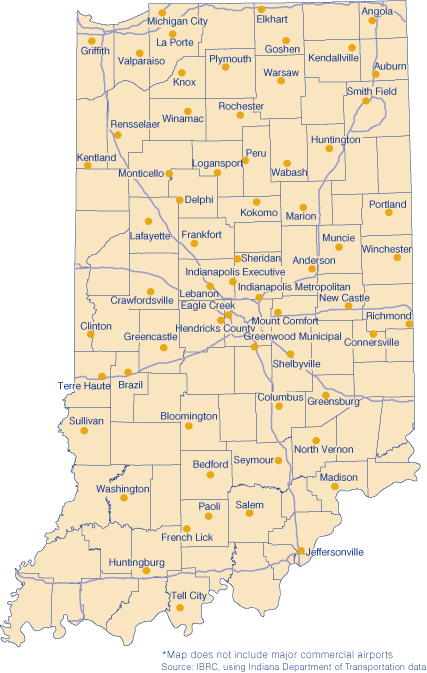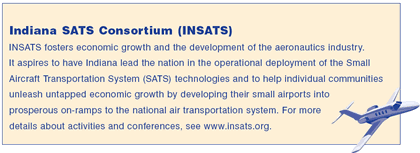Getting Indiana Off the Ground
Indiana has a chance to be at the forefront of a major change in air transportation. Cities and towns of all sizes will have more options to use the airways and companies will have larger market areas; many new and existing firms will have opportunities to participate in a growing market. This is the potential offered by the Small Aircraft Transportation System (SATS).
The Vision
A little more than 100 years ago, a revolutionary event in history occurred with little media attention or public fanfare. Two Ohio bicycle makers, one of whom was born in Indiana, first achieved power flight.
Recently at Danville Virginia, with modest media fanfare, SATS was presented to the public. This presentation exhibited years of innovative aviation research supported jointly by the Federal Aviation Administration (FAA) and the National Aeronautics and Space Administration (NASA).
One goal of SATS is to provide the nation with an economic development tool for communities of all sizes, enabled by local air accessibility, bypassing hub-and-spoke air transportation constraints and delays. Another goal is to relieve the over-burdened air-traffic control network.
SATS is a revolutionary departure from previous economic transportation models. Historically, transportation and economic development has been along paths or lines. Community prosperity required being on a line (no matter how circuitous): a river, seaport, path or road. Next came canals and railroads followed by paved highways and then interstate highways. Airlines put cracks in this model with point-to-point transportation. But the industry was dominated by economies of scale that left out smaller communities and airports. SATS will break the old linear model with a new, highly flexible transportation network that makes each community the center of its own economic radius.
What is SATS?
The Small Aircraft Transportation System is just that—a system with technological and organizational components. On the technology side, SATS is a dramatic upgrade—both in the vehicle and on the ground—and would eliminate much of the complexity in today’s aviation. Instead of a pilot facing an intimidating array of dials, all necessary information is available on a single screen. On-board computers monitor systems and relate information as needed to the screen so the pilot can concentrate on essential functions. Via an airborne Internet system, planes are able to communicate with each other, sequencing landings and preventing mid-air collisions. In most cases, SATS eliminates the need for two pilots in the cockpit.
On the ground, a Geographic Positioning System (GPS) with computer communications to air-borne traffic provides information that allows landings at much lower visibility levels than are possible today. There is little, if any, need for SATS-equipped aircraft to use the already over-burdened air traffic control system.
There are more than 60 airports in Indiana with runways long enough for SATS aircraft (see Figure 1). They require, however, installation of a GPS-based communication system (estimated to cost as little as $50,000) for use by SATS-equipped airplanes.
Figure 1: Airports with Runways Long Enough for SATS*

As NASA and the FAA refine the SATS technology, the aviation industry is undergoing a major transformation. A new generation of low-cost jets is being built using the latest advanced manufacturing techniques. Thus, new air-taxi or on-demand services will be available at airports that currently have enormous excess capacity. As aircraft ownership costs decrease dramatically, there will also be a rise in the availability of air-taxi services using sophisticated scheduling programs to improve service and drive costs even lower. These new SATS-equipped aircraft will be in the air in the coming year.
Economic Implications
SATS will create jobs for those who manufacture the planes and complementary equipment. Indiana needs to explore this opportunity as a replacement for declining employment in the automotive sector.
SATS will create jobs at airports to service airplanes arriving and departing, as well as jobs for those who fly the planes. It will lower the costs of existing travel, increasing the earnings of firms. It will also create jobs because firms will be able to generate more business by traveling more often.
If you live in Logansport, Richmond, Frankfort, Connersville or any other Indiana city with a small airport, SATS gives you new choices. But, you do not necessarily have to live in a small town. You could be living on the eastside of Indianapolis, near the Mount Comfort Airport, or in Lake County, not far from the Gary or Griffith airports. SATS opens up new opportunities to avoid the costs and discomforts of major airports.
Some existing travel will be diverted from autos to air-taxis. Instead of driving from Kokomo to Tell City, a traveler could fly. Instead of a five-hour drive in each direction, the flight would be under an hour each way. Eight hours of travel saved, to say nothing of the fatigue.
SATS will also substitute for some combined auto-air travel. Today a traveler from Muncie going to Anniston (AL) drives to the Indianapolis airport (about an hour and a half), flies to a hub city (Chicago, Memphis, Atlanta or Detroit), transfers to a flight to Birmingham (best elapsed time: three hours and 20 minutes) and then drives to Anniston (about an hour). Total time for the trip: close to six hours excluding parking, security and the usual airport hassle. But a direct flight from Muncie to Anniston would be less than two hours. Again, the total time savings of SATS would be eight hours for the round-trip.
Hence, SATS will get some travelers to change their mode of transport. But it will also induce those who are currently not travelers to make trips they are not now taking. These induced trips became the focus of a study by the Indiana SATS Consortium.

Induced Business Activity Model
This model is built on the idea that firms will expand their markets if less-time-consuming modes of transportation are available. It ignores in-bound business activity that can benefit a community and non-business flights. It contains several variables or assumptions that can be changed at will. Given the absence of existing empirical data for such a revolutionary service, this approach, using very conservative assumptions, offers a minimalist estimate of the economic value of SATS to existing businesses in a county.
- To estimate induced activity, the number of establishments for each U.S. county was drawn from County Business Patterns produced by the U.S. Census Bureau. The data were reduced to five sectors: manufacturing, information, finance and insurance, professional and technical services, and a residual sector. For each sector, a minimum number of flights per year per establishment was assumed. For example, manufacturing firms were assumed to take one flight per year per establishment. Other sectors were assumed to take fewer flights per establishment. This produced the number of flights for each sector and each county.
- Each flight taken was assumed to have a fare of $1,800 (based on calculations by Virginia Tech) and to have two executives onboard. The value of executive time was assumed to be 150 percent of the average earnings per worker in that sector in that county as calculated from data generated by the U.S. Bureau of Economic Analysis (BEA). This time cost was added to the fare to give a total cost for the trip.
- The value of the trip to the firm was assumed to be equal to the cost of the trip times the ratio of the value of output to employee compensation for each sector. Those data are not available at the county level, so state level gross state product estimates from the BEA were used. The thought here is that a firm would not undertake a trip without a return equal to the value it would obtain from a like investment in employee compensation.
- A business trip may be expected to generate additional orders that can be realized without additional trips. Relationships established by the initial trip can be strengthened by telephone and e-mail so that repeat orders may be created. A repeat business coefficient was applied for each sector.
- From these basic sources and assumptions, the model generates the increases of output, earnings and employment in each county within the 48 continental states.
This is how it worked out for Adams County in Indiana (dollars are expressed in 2002 values with no adjustment for inflation):
- Value of added output in the community = $3.2 million
- Amount of added earnings by workers and business proprietors in the community = $2.0 million
- Increased number of jobs in the community = 72
What would a community spend as incentives today to get 72 jobs tomorrow? If SATS costs $50,000, it would be the bargain of the century.
The ultimate economic development issue, it appears to us, is to get the planes flying, which does involve some minimal investment at airports, and to get business passengers in the seats (a marketing effort by air-taxi operators). The normal functioning of markets will do the rest.
By Morton Marcus, Director Emeritus
Indiana Business Research Center, Kelley School of Business, Indiana University
and Ted Jockel, Independent Economic Consultant
